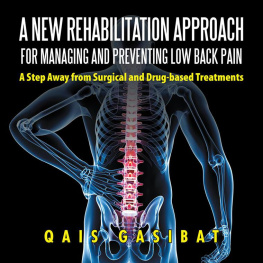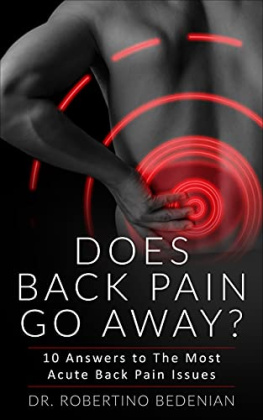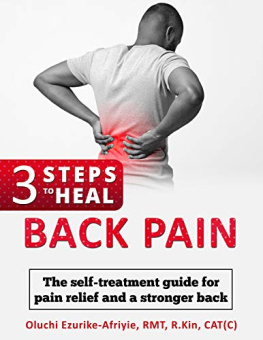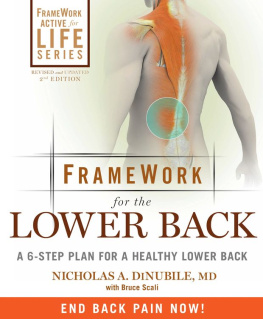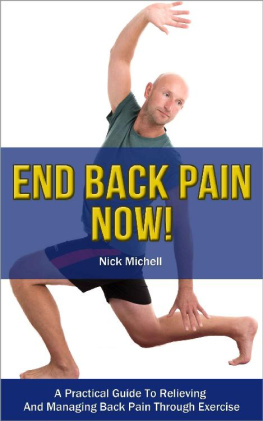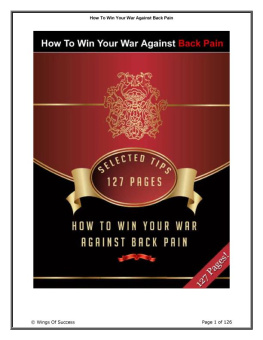A NEW REHABILITATION APPROACH
FOR MANAGING AND PREVENTING LOW BACK PAIN
A Step Away from Surgical and Drug-based Treatments
QAIS GASIBAT
Copyright 2017 Qais Gasibat. All rights reserved.
ISBN
978-1-5437-4284-8 (sc)
978-1-5437-4285-5 (e)
All rights reserved. No part of this book may be used or reproduced by any means, graphic, electronic, or mechanical, including photocopying, recording, taping or by any information storage retrieval system without the written permission of the publisher except in the case of brief quotations embodied in critical articles and reviews.
Because of the dynamic nature of the Internet, any web addresses or links contained in this book may have changed since publication and may no longer be valid. The views expressed in this work are solely those of the author and do not necessarily reflect the views of the publisher, and the publisher hereby disclaims any responsibility for them.
www.partridgepublishing.com/singapore
09/12/2017

Contents
This book entitled A New Rehabilitation Approach for Managing and Preventing Low Back Pain: A Step Away from Surgical and Drug-based Treatments has been written to provide LBP patients with a sensible, logical, and beneficial information about the use of exercises for the treatment of LBP. It is a useful and easy-to-use reading material based on the authors many years of research and experience in the field of Physiotherapy. It addresses the need for an alternative to surgical and drug-based treatments of LBP that everyone needs to know. This book can be used by patients with LBP who are looking for a lasting solution to their back problems.
The books step-by-step explanation makes it suitable for both individual and classroom usages. Its detailed description of how to use the best exercises I summarised for LBP treatment makes it particularly valuable to everyone, since you might have personally experienced problems with your back, or you are close to someone who has had a bad experience with his or her back. All sections in this book are carefully designed to focus on valuable back-related information that can help in understanding complex back problems. This is because at times the pain you feel in the back might be complicated without the back being the culprit. On the cover page, I provide the readers with a brief description of the content of this book.
In this comprehensive guidebook, I provide an in-depth look into how the back works and then delves into other sections, discussing the three hidden causes of back pain, pregnancy and LBP, commonly used interventions and treatments, the proper way to use your back, and exercises that can strengthen the back and ensure flexibility. I also include wide-ranging illustrations that highlight the complex workings of the spine, describe osteoporosis and other spine-related ailments, and demonstrate the correct posture. As a physiotherapist, I lead back pain sufferers through a step-by-step process that can encourage regular exercise and provide alternative methods to pain relief.
This book has been a labour of love, supported and enhanced by my family. My wife Naseem and our children, Elean and Talean, allowed me time to write on weekends, time which is usually reserved for them. I am indebted to my friends, Abdulazim Ali Elaati and Mohamed Alrshah; their advices and counsel were invaluable. Without the help and support of these wonderful people, this book would not have been possible. I also express my profound gratitude my supervisor, Prof. Doctor Nordin Bin Simbak and my co-supervisor, Prof. Doctor Aniza Abd Aziz. They spent numerous hours reviewing my manuscript and contributed throughout the book-writing process, sharing their previous experience regarding lower back pain patients. I also express my gratitude to Sultan Zainal Abidin University especially the library staff, for providing the necessary facilities to enable me write this book.
Low Back Pain
You are probably reading this book because you have personally experienced problems with your back, or you are close to someone who has had a bad experience with his or her back. In any case, Low Back Pain (LBP) is a pain localized to the lumbar area ranging from the inferior ribcage to the waistline (12 th thoracic/1 lumbar to 5 th lumbar/1 st sacral vertebrae) and often includes radiating leg pain such as sciatica. It is often labelled non-specific being described by the National Institute for Health and Clinical Excellence as tension, soreness and stuffiness in the lower back region for which it is not possible to identify a specific cause of the pain. It is estimated that in as much as 85% of LBP cases no specific pathoanatomical diagnosis can be found.
A study conducted in 1999 found that 1:25 people will change their jobs because of LBP or retire early due to disability stemming from low back pain. Studies in Europe found that many work days were lost because of low back pain. In the UK, more than 100 million work days were lost per year. Other studies in the US demonstrated that 149 million days of work were lost. In the US, roughly 80 million individuals have had or are experiencing back pain. LBP is the costliest condition; The US spends 100 to 200 billion annually, two-thirds of which are due to decreased wages and productivity. In the UK, 1632 million pound was spent in 1998. LBP is also a significant problem in Asian communities. The prevalence of LBP is 28.5% in Asian count ries.
At the meeting of the American Institute of Orthopaedic Specialists, there were about one hundred papers, instructional courses, and workshops that dealt exclusively with LBP. Back pain is ubiquitous; it knows no boundaries and is seen in every walk of life. Something that always arises is whether or not back pain is a fresh problem for people. Did the farmers, labourers, artisans, troops, and professional people of the past experience the same magnitude of back problems as contemporary people do? Or is something new happening, which is maybe linked to the greater emotional and physical stress associated with interruptions in peoples habits with this changing world? These queries are difficult to answer since we do not have available data to create scientific comparisons. We do know that back pain is not brand-new. Indeed, doctors, faith healers, surgeons, chiropractors, and osteopaths have applied various skills to relieve the pain of those sufferers for centuries. In all instances, however, treatment followed discomfort. Until recently through this century, there was little focus on how to prevent back pain.
The sad truth is that though most treatment is successful in relieving the pain, attacks are usually recurrent. Different factors can cause back pain. We know that back concerns seem to run in some households, so perhaps hereditary factors play a role. For years, the very fact that man has been standing straight, rather than on all limbs, has been considered a significant cause of stress for the lower back. However, even four-legged animals like the dachshund develop slipped disks in their spines. Research to determine the effects of training and bending on the spinal column is done at dozens of therapeutic centres throughout the world. The Volvo car makers, with the guidance of orthopaedic surgeons, have analysed the effect that car seats have on the back. Sports medicine centres advertise exercise courses for back sufferers and for those who wish to avoid these kinds of perplexing complications.
We are immersed in a plethora of information, much of it unfinished, some of it contradictory, and a lot of it confusing. After almost thirty years of treating and studying patients with back problems and having to deal with my own personal back problem, I feel that I can assist people, not only to get over their very own back pain, but also to avoid it in the first place. In this book, I shall show you how to do both equally. Before you can embark on a plan for a healthy back, you need to be aware of what constitutes a healthy and balanced back. This book is tailored for you. But do not get worried, ensuing sections describe just how back problems are identified and treated, I will describe and illustrate the exercise programmes that allow us to strengthen and protect our back. The only one who can in the end make your back better is you. It is not as hard to do as it sounds. Experience has shown that 90% of the people who have back pain get better with time, without even any treatment. The crucial concern is to prevent it occurring again and again, which is the distressing aspect of low-back troubles. I hope you have stimulated the interest. Now, read on to see what you need to know about back pain and the way to have a healthy back.
Next page
